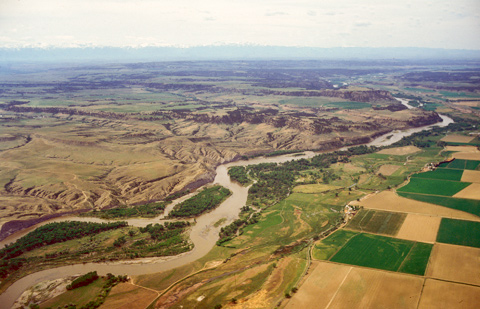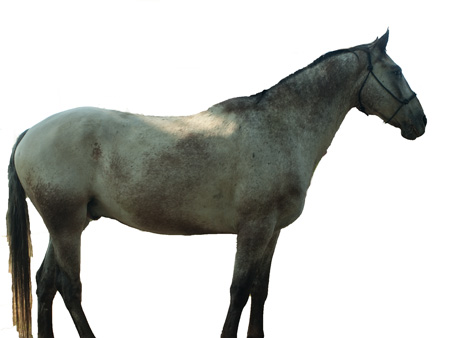One week and a hundred miles after starting down the Yellowstone River, Clark finally found cottonwood trees large enough for building canoes, though they would not quite meet previous standards. “Those trees,” he wrote on 20 July 1806, “appeared tolerably Sound and will make Canoes of 28 feet in length and about 16 or 18 inches deep and from 16 to 24 inches wide.” The men would have to lash them together, catamaran-style, for stability.
Clark’s party made camp at today’s Park City, Montana, and settled in to build the new canoes and attend to other business. While a few of the men took turns with the three axes they had along, some of the rest, being nearly naked, made elk- and deer-skin clothing. Clark himself tended to Private George Gibson, who had punctured a thigh on a fallen tree when bucked off his horse. Some of the men hunted, some dried meat, and others looked after the horses. Between chores they rested up.
Stolen Horses
Appaloosa Horse
© 2010 by Kristopher K. Townsend. Permission to use granted under the Creative Commons Attribution-Share Alike 4.0 International license.
On the 20th the contingent camped near today’s tiny settlement called Park City, and began carving out a couple of cottonwood canoes. That night, beneath a waxing crescent of moon, some Indians—almost certainly Crow—made off with half their horses.[1]Upon leaving Travelers’ Rest on 3 July 1806, Clark’s group had 49 horses, of which nine of the most valuable were stolen during the night of the 6th—by Shoshone “spies,” … Continue reading
At dawn, Clark immediately sent George Shannon, William Bratton and Charbonneau to hunt for them:
Shabono and Bratten returned at 10 A M and informed me that they Saw no Signs of the horses. Shannon proceeded on down the river about 13 miles and did not return untill late in the evening, he was equally unsuckcessfull.
Young Shannon’s courage seems extraordinary, but it was routine for the members of the Corps of Discovery.
Clark ordered three men to guard the balance of their herd that night, but “on their approach near the horses were So alarmed that they ran away and entered the woods and the men returned.”
Clark composed a serious lecture, alternating diplomacy with diatribe, to deliver if and when he caught up with the culprits’ chief (See Clark’s Crow Indian Speech). On 21 July 1806, Clark dispatched Pryor, Charbonneau, Windsor and Labiche on the same sort of mission. But the plains were so dry and hard that no tracks could be found. Meanwhile, the knowledge that they were being watched, and that those watchers were very bold and stealthy, must have made every member of the party somewhat on edge.
On the 23rd:
Sgt. pryor found an Indian mockerson and a Small piece of a roab, the mockerson worn out on the bottom & yet wet, and have every appearance of haveing been worn but a fiew—
(He hears few as a two-syllable word—fee-yoo.)
—a fiew hours before. Those Indians Signs is Conclusive with me that they have taken the 24 horses which we lost on the night of the 20th instant, and that those who were about last night were in Serch of the ballance of our horses which they could not find as they had fortunately got into a Small Prarie Serounded with thick timber in the bottom. Labeech returned haveing taken a great Circle and informed me that he Saw the tracks of the horses makeing off into the open plains and were by the tracks going very fast. The Indians who took the horses bent their course reather down the river.
Setting Out Again
On the 24th Clark and seven men—Bratton, Gibson, Hall, Labiche, Shields, Charbonneau and York—plus Sacagawea and baby Jean Baptiste Charbonneau, set out in the two small dugouts, which are lashed together for stability. Sergeant Pryor, with Privates Shannon and Windsor, proceed down the north side of the river with the remaining 24 horses. That evening they drive the horses over to the south side of the river, and ferry across the three men, plus Private Hall. Pryor and his three men are to take the horses back to the Knife River Villages, leave about half of them there, and take the rest up to Fort Assiniboine.
Now they are more vulnerable than they have ever been. Their survival is in the hands of the Crow Indians. On the night of the 25th, under an almost full moon, someone creeps to within 100 yards of where Pryor and his men lie sleeping, and makes off with the rest of the horses.
The “chapter of accidents” isn’t over. In the middle of the night after the horses are stolen, a wolf bites the sleeping Pryor on the hand, and then goes after Windsor. Quick-shot Shannon promptly sees to it that the wolf has a fatal accident.
Clark’s Canoe Camp on the Yellowstone is a High Potential Historic Site along the Lewis and Clark National Historic Trail managed by the U.S. National Park Service. The site is on private property.—ed.
Notes
| ↑1 | Upon leaving Travelers’ Rest on 3 July 1806, Clark’s group had 49 horses, of which nine of the most valuable were stolen during the night of the 6th—by Shoshone “spies,” Clark figured. Sentries were posted every night, but their primary duty was to guard the camp. Horses will feed all night, moving continually in search of more grass. Even hobbled horses can move faster than person can run, if they want to. Picketing (tying horses to trees or picket pins) is impractical with a herd as large as 50. See Stolen Horses. |
|---|
Experience the Lewis and Clark Trail
The Lewis and Clark Trail Experience—our sister site at lewisandclark.travel—connects the world to people and places on the Lewis and Clark Trail.
Discover More
- The Lewis and Clark Expedition: Day by Day by Gary E. Moulton (University of Nebraska Press, 2018). The story in prose, 14 May 1804–23 September 1806.
- The Lewis and Clark Journals: An American Epic of Discovery (abridged) by Gary E. Moulton (University of Nebraska Press, 2003). Selected journal excerpts, 14 May 1804–23 September 1806.
- The Lewis and Clark Journals. by Gary E. Moulton (University of Nebraska Press, 1983–2001). The complete story in 13 volumes.





